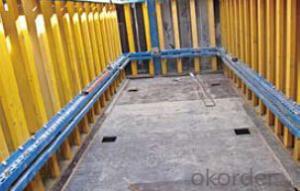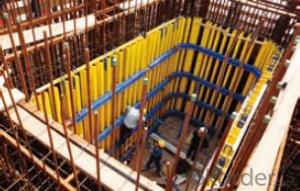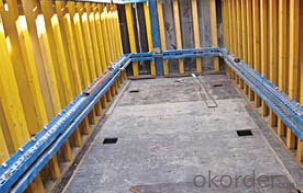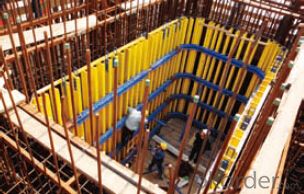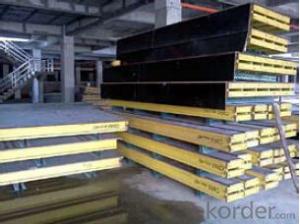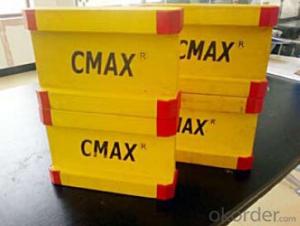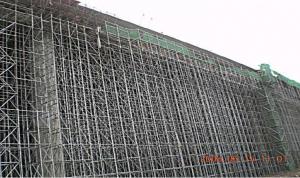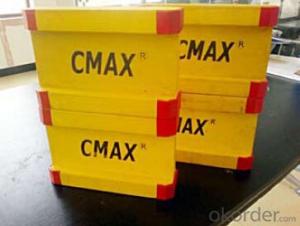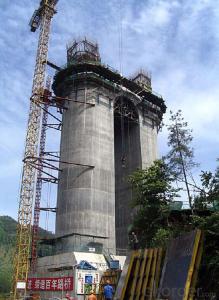Shaft-platform S40 System for Formwork and Scaffolding
- Loading Port:
- Tianjin
- Payment Terms:
- TT OR LC
- Min Order Qty:
- 50 m²
- Supply Capability:
- 1000 m²/month
OKorder Service Pledge
Quality Product, Order Online Tracking, Timely Delivery
OKorder Financial Service
Credit Rating, Credit Services, Credit Purchasing
You Might Also Like
Shaft Platform
As operating platform, the shaft platform is mainly used in the concrete pouring of elevator shaft,
equipment shaft, stair shaft of high-rise building and so on.
Characteristics:
◆ The length of shaft beam is adjustable.
◆ Flexible structure makes lifting easier.
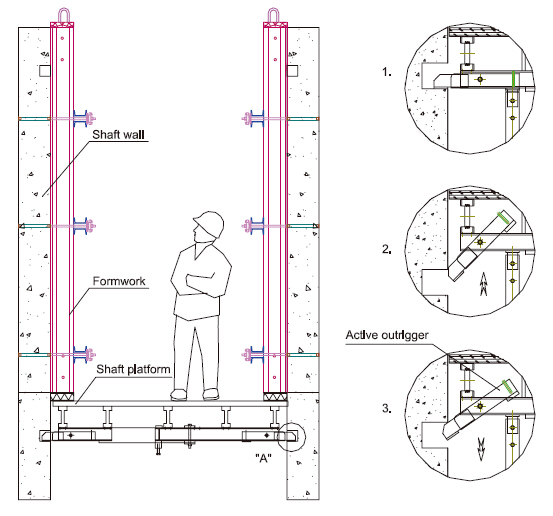
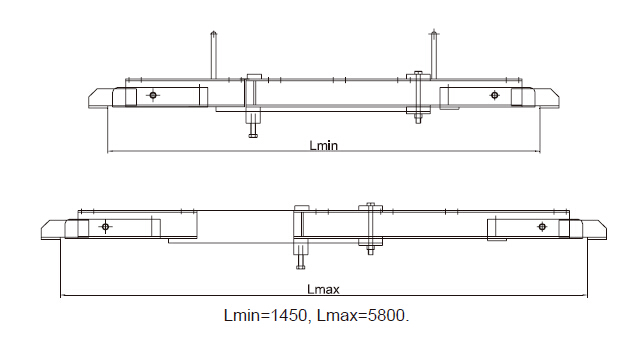
- Q: How does steel formwork contribute to the overall fire resistance of the structure?
- Steel formwork does not directly contribute to the fire resistance of a structure. Fire resistance is primarily determined by the materials used in the construction of the building, such as the type of steel used in the structural framing, the fire-rated insulation and coating materials applied, and the overall design of the building to ensure fire safety. However, steel formwork can indirectly contribute to the fire resistance of a structure by facilitating the construction of fire-resistant elements. Steel formwork is commonly used in concrete construction to create walls, floors, and other structural elements. By providing a strong and stable framework for pouring concrete, it enables the construction of fire-resistant concrete walls and floors that can withstand high temperatures and protect the structure from the spread of fire. In addition, steel formwork can be used to create fire-rated concrete enclosures for stairwells, shafts, and other areas where fire protection is crucial. These enclosures help contain the spread of fire and provide safe escape routes for occupants during a fire emergency. Furthermore, steel formwork can be designed to incorporate fire-resistant materials such as fire-rated insulation boards or coatings. These materials can be applied to the formwork surface before pouring concrete, adding an extra layer of fire protection to the resulting structure. Overall, while steel formwork itself does not directly contribute to the fire resistance of a structure, it plays a vital role in enabling the construction of fire-resistant elements and facilitating the incorporation of fire protection materials. By ensuring the proper construction of fire-resistant concrete walls, floors, and enclosures, steel formwork indirectly contributes to the overall fire resistance and safety of the structure.
- Q: What are the common types of connections used in steel formwork systems?
- The common types of connections used in steel formwork systems include bolted connections, welded connections, and adjustable connections.
- Q: Can steel formwork be used for fire-resistant concrete structures?
- No, steel formwork cannot be used for fire-resistant concrete structures. Steel is highly susceptible to heat and can lose its structural integrity when exposed to high temperatures, thus compromising the fire resistance of the concrete structure. Fire-resistant concrete structures require specialized forms made of non-combustible materials, such as fire-rated plywood or fiber-reinforced plastic, which can withstand extreme heat and maintain the integrity of the structure during a fire.
- Q: What materials are used in steel formwork construction?
- Steel formwork construction primarily involves the use of steel sheets, beams, angles, channels, brackets, and fasteners, such as bolts and screws.
- Q: What are the different types of steel formwork available?
- In the construction industry, there exists a variety of steel formwork options, each possessing its own distinctive characteristics and benefits. Some of the most prevalent variations include: 1. Modular steel formwork: This formwork type comprises pre-made steel panels that can be effortlessly assembled and disassembled. It boasts customization capabilities and can accommodate concrete structures of diverse shapes and sizes. 2. Tunnel formwork: Specifically designed for tunnel and underground structure construction, this formwork variant is forged from steel plates. Its robust construction enables it to withstand high pressure and deliver a polished finish to the concrete. 3. Climbing formwork: Tailored for tall structures such as skyscrapers, climbing formwork is engineered to be lifted and moved vertically as construction progresses. This type of formwork ensures both safety and efficiency during the construction of multi-story buildings. 4. Steel soldier formwork: A versatile and cost-effective option often employed for walls and columns, steel soldier formwork is constructed using steel beams and soldiers. It can be easily adjusted to accommodate different heights and widths. 5. Steel frame formwork: Comprised of steel frames with attached plywood or metal panels, this lightweight formwork type is easy to handle and guarantees a smooth concrete finish. 6. Steel table formwork: Ideal for large horizontal slabs, steel table formwork utilizes steel tables supported by props or scaffolding. Its quick assembly and dismantling make it perfect for projects with tight timelines. These examples represent only a fraction of the available steel formwork options. The selection of formwork depends on project-specific requirements, including the structure type, load-bearing capacity, and desired finish.
- Q: How does steel formwork affect the overall cost of concrete construction?
- Steel formwork can increase the overall cost of concrete construction due to its higher initial investment compared to other formwork materials. However, it offers several advantages such as durability, reusability, and better quality finishes, which can result in cost savings in the long run by reducing the need for frequent replacements and rework. Additionally, steel formwork allows for faster construction and improved productivity, which can offset the initial cost by reducing labor expenses and project timelines.
- Q: How does steel formwork contribute to the overall durability of a structure?
- Steel formwork contributes to the overall durability of a structure by providing a strong and rigid framework during the concrete pouring process. It ensures accurate and precise shaping of the concrete, resulting in a solid and uniform structure. Steel formwork is highly resistant to warping, bending, and cracking, making it more durable than other types of formwork materials. Its strength and durability allow for multiple reuse, reducing construction costs and minimizing waste. Additionally, steel formwork provides excellent support for the concrete as it cures, preventing any deformation or collapse. Overall, steel formwork plays a crucial role in enhancing the longevity and robustness of a structure.
- Q: How does steel formwork prevent concrete segregation?
- The use of steel formwork is essential in preventing concrete segregation. This is because steel formwork offers a sturdy and unyielding structure for the concrete to be poured into. Unlike wood or plastic formwork materials, steel formwork remains intact and free from any movement or distortion throughout the pouring and curing process. Concrete segregation arises when the different constituents of concrete, namely cement, aggregates, and water, separate from one another. This leads to an uneven distribution of these constituents within the mixture. Consequently, the concrete structure becomes weakened, causing problems such as reduced strength, cracking, or the formation of voids. Steel formwork effectively combats concrete segregation by providing a smooth and uniform surface for the concrete to be poured onto. The inflexible nature of steel ensures that there are no gaps or spaces for the concrete constituents to separate or settle unevenly. This guarantees a consistent and even distribution of cement, aggregates, and water throughout the entire concrete mixture. Furthermore, steel formwork creates a tight seal against the sides and bottom of the form, preventing any leakage or loss of moisture during the curing process. This is crucial in maintaining the desired water-cement ratio, which is vital for the proper hydration and solidification of the concrete. By averting excessive evaporation or moisture loss, steel formwork ensures that the concrete cures uniformly, minimizing the risk of segregation. Moreover, the use of steel formwork allows for precise and accurate placement of the concrete, eliminating any potential gaps or voids that could contribute to segregation. The design of steel formwork can incorporate various features such as tie rods, clamps, or connectors to securely hold the formwork panels in place. This guarantees that the concrete is poured and compacted uniformly, ensuring a homogeneous mixture. To summarize, steel formwork serves as a reliable solution to prevent concrete segregation. It offers a stable and inflexible structure that upholds the shape and integrity of the concrete mixture. By preventing the separation of constituents, ensuring a consistent distribution of materials, and enabling accurate placement of the concrete, steel formwork results in a stronger and more durable structure.
- Q: How does steel formwork handle different concrete curing time requirements?
- Steel formwork is a versatile and durable option for construction projects, including concrete structures. When it comes to handling different concrete curing time requirements, steel formwork offers several advantages. Firstly, steel formwork provides a robust and stable framework for the concrete to be poured into. This ensures that the concrete is held in place and maintains its desired shape during the curing process. Regardless of the required curing time, steel formwork can effectively support the weight and pressure exerted by the concrete, preventing any deformation or collapse. Moreover, steel formwork is highly adjustable and customizable. It can be easily modified to accommodate different curing time requirements. For instance, if a particular section of concrete requires a longer curing time, additional support can be added to the steel formwork to provide extra strength and stability. On the other hand, if a section requires a shorter curing time, the steel formwork can be adjusted accordingly to facilitate quicker curing. Additionally, steel formwork has excellent heat conductivity properties. This allows for efficient heat dissipation during the concrete curing process. Different concrete mixes may have varying heat generation rates during hydration, and steel formwork aids in maintaining uniform curing temperatures. This is particularly beneficial when dealing with concrete structures that have specific curing temperature requirements. Furthermore, steel formwork is reusable and can withstand multiple casting cycles. This means that it can be used for different projects with varying concrete curing time requirements, making it a cost-effective option. The durability and strength of steel formwork ensure its longevity, enabling contractors to adapt to different curing time requirements without the need for constant replacement. In conclusion, steel formwork is well-suited to handle different concrete curing time requirements. Its stability, adjustability, heat conductivity, and reusability make it an ideal choice for construction projects of various scales and complexities. Whether the concrete requires a longer or shorter curing time, steel formwork provides the necessary support and flexibility to ensure successful curing and the creation of strong and durable concrete structures.
- Q: What are the different types of release agents used with steel formwork?
- There are several different types of release agents that can be used with steel formwork. Some of the most common types include: 1. Water-based release agents: These types of release agents are composed primarily of water, with additives such as surfactants and lubricants. They are environmentally friendly and easy to apply, typically by spraying or brushing onto the steel formwork. Water-based release agents form a thin film on the surface of the steel, preventing adhesion of the concrete during the curing process. 2. Solvent-based release agents: Solvent-based release agents use organic solvents as the carrier for the active ingredients. They are effective in providing a smooth surface finish on the concrete and are often used in situations where a higher level of release performance is required. Solvent-based release agents are typically applied by spraying or brushing and evaporate quickly, leaving a thin film on the steel formwork. 3. Barrier release agents: Barrier release agents are typically applied as a thick paste or gel and provide a physical barrier between the steel formwork and the concrete. They are often used in situations where a high-quality surface finish is required, such as architectural concrete applications. Barrier release agents can be applied by brushing or troweling onto the steel formwork. 4. Dry release agents: Dry release agents are powdered or granular materials that are applied directly to the steel formwork. They create a non-stick surface by absorbing excess moisture from the concrete, preventing adhesion. Dry release agents are commonly used in situations where other types of release agents may not be suitable, such as in cold weather conditions. 5. Form release oils: Form release oils are petroleum-based products that are commonly used with steel formwork. They provide an effective release barrier between the steel and the concrete, preventing adhesion. Form release oils are typically applied by spraying or brushing onto the steel formwork and can be used in a variety of concrete applications. It is important to select the appropriate type of release agent based on the specific requirements of the project, including the desired surface finish, environmental considerations, and ease of application. Consulting with a professional or manufacturer's recommendations can help determine the most suitable release agent for a particular steel formwork application.
Send your message to us
Shaft-platform S40 System for Formwork and Scaffolding
- Loading Port:
- Tianjin
- Payment Terms:
- TT OR LC
- Min Order Qty:
- 50 m²
- Supply Capability:
- 1000 m²/month
OKorder Service Pledge
Quality Product, Order Online Tracking, Timely Delivery
OKorder Financial Service
Credit Rating, Credit Services, Credit Purchasing
Similar products
Hot products
Hot Searches
Related keywords
